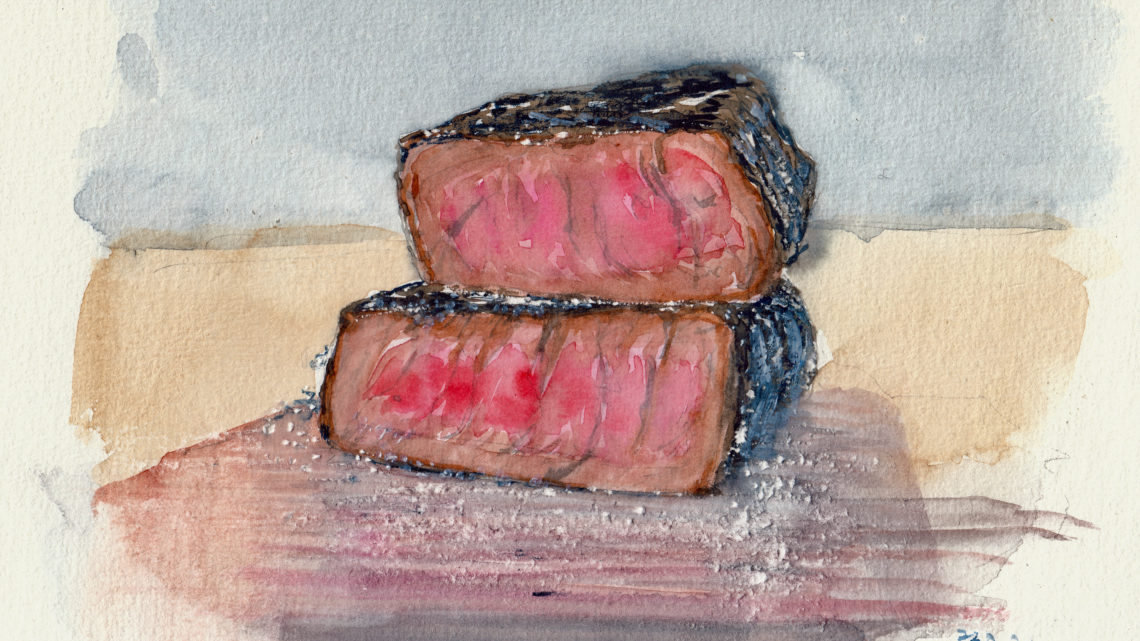The 54th edition of the Taittinger – International Prize for Author’s Cuisine will take place on May 31st 2022. On the occasion, Chef Bruno Verjus (Restaurant Table in Paris, 1 Michelin star) gives us a story around the imposed theme: The beef.
According to family legend, my great-grandfather travelled across Europe with his only cow — probably a grey one from Hungary — to go to Renaison, France. A village in the Loire, where the valleys of this “little Switzerland” reminded him of his homeland, Upper Silesia. Well, I retained a taste for travel – and for cows. Whether from the Bretonne Pie Noir dairy cattle, Flanders Red Cattle, Jersey or Froment du Léon breeds, I enjoy milk from each of them. High concentrations of butyric acid (fat) makes it caress your palate like a beauty cream. More still, I love the Abondance, Maraîchine, Maine-Anjou, and Normande cow breeds, for their addiction to flowers and coumarin in those fragrant grasses replete with gourmet promises. If everything is good in the pig, everything in the cow is a pure delight. True virtue and even sacred in Indian dung. Moreover, smoking dried dung from “Bijou”, a winemaker’s magic cow in the Auvergne region, makes minds fly.
The University of Boston goes as far as praising the anti-wrinkle potential of cow drool, which it considers miraculous, doesn’t it? Its urine would be worth its weight in gold, since it is said to contain 10 mg per litre! Finally, their milk is a medical panacea, due to its peptides with hypotensive effects. But the Cow does not require these stooges to express the joy of living and eating, to the point where it sacrifices its body to food-lovers.
Every part of its life cycle has a key asset. From producing calves and milk to finishing its reproductive phase after twelve, thirteen, or even seventeen years, this phase reaches a grateful end after seeing many trains go by, thus giving us its flesh in return for food.
That is the fate of these “mother” cows fattened with grass and grains. A pagan Eucharist. These animals, raised by originally pagan village peasants, embody celebrations of the virtuous circle of life, where the well-bred joins the well-nourished.
In my restaurant Table, I only work with beef from old cattle breeds who have reached the end of their life cycle. The aloyaux (sirloin steak cut from the back of the cow), are matured on their bones for a few weeks. During this maturation, the glycogen in their muscles transforms into lactic acid. The meat’s pH, thus lowered, generates enzymes called proteases, which catalyze the breakdown of protein, and the meat becomes tender. Other enzymes, the lipases, also contribute to the development of a fine meat aroma.
When cooking, you have to get a good Maillard reaction. I like to cook a nice rib steak in a frying pan, studded with grains of salt. The salt grains snap like firecrackers calling out to the meat. Frying pans provide the ideal temperature. The marbled chop’s swollen fat melts. The meat “sings” in a quick rhythm. It should be turned frequently so all its juices can circulate through the tissue, thus ensuring a savoury taste. The caramelization of sugars and proteins is underway. That’s the Maillard reaction for a rib steak, thus seared and browned on both sides. Then it can have a well-deserved rest at a temperature of 50°C, no more. To make it crispy, return it to the very hot frying pan one last time, and then it’s ready to be cut. Its slices will be covered with golden browns, pale pinks, and crimson reds. For their final journey to your mouth, I like to serve them with a nice Santona anchovy for a salty, iodized note.




